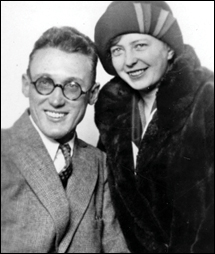Biography
Maria Goeppert-Mayer • 1905-1972
“Winning the prize wasn’t half as exciting as doing the work itself”
Maria Göppert came from a family of academics. Her father was a professor of pediatrics and the seventh generation of university scholars in his family. When Maria was four, he moved the family from Katowice, Germany to Göttingen so he could teach there. Maria idolized her father. It was expected that she acquire an education because of her family pedigree in academics. Maria attended a small private school that prepared girls for the university entrance exams. In 1924 she enrolled at Göttingen in mathematics.
Göttingen was then a world center for physics (and the new study of quantum mechanics). The Göppert family had friends who were prominent scientists, and Maria’s social contacts included Niels Bohr and her teacher, Max Born. While attending Born’s physics seminar, Maria decided to study physics instead of mathematics. Born’s other students included Fermi, Oppenheimer, Dirac, and von Neumann. Maria thrived in this environment. For her dissertation (1930), she calculated the probability that an electron orbiting an atom’s nucleus would emit two photons of light as it jumped to an orbit closer to the nucleus. Her challenging calculation was confirmed experimentally in the 1960s.
Maria married physical chemist Joseph E. Mayer in 1930 and together they moved to Baltimore, where Joe was a professor at Johns Hopkins. Maria adopted a hyphenated form of their names and anglicized the spelling. She had an attic office and a mixed assortment of honorary job titles, but no pay. She nevertheless produced ten papers, a textbook, and her daughter Maria Ann during her time in Baltimore. She was pregnant with her son John in 1938 when Joe unexpectedly lost his job. They left Hopkins for Columbia University.
At Columbia, they wrote a classic textbook, “Statistical Mechanics.” Again, Goeppert-Mayer had office space, but no pay. During the Second World War, she worked on uranium isotope separation, under Harold Urey and others who helped develop the atom bomb. After the war, the Columbia physicists moved to Chicago, and the Mayers followed.
Maria worked at the Institute for Nuclear Studies at the University of Chicago and at Argonne National Laboratory. In 1948 she started her work on the nuclear shell model. Chicago received her willingly and gave her great respect, but no salary. In 1956, she was elected to the National Academy of Sciences. Three years later, she and Joe accepted professorships at the new University of California campus at San Diego.
When the Nobel Prize was awarded to her in 1963, a San Diego newspaper ran the headline “S.D. Mother Wins Nobel Prize.” Shortly afterward, her health began to decline and she died in 1972. (written by Merry Maisel - San Diego Supercomputer Center)
